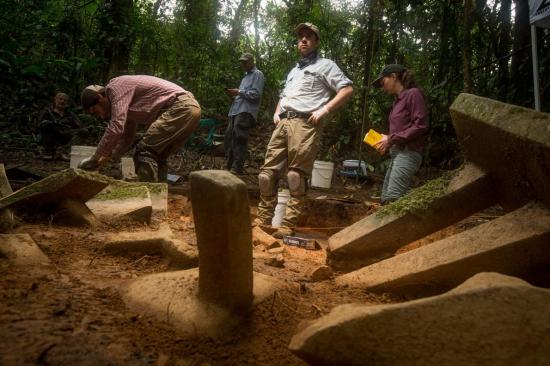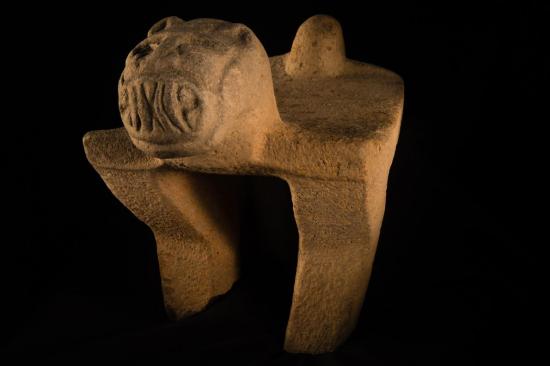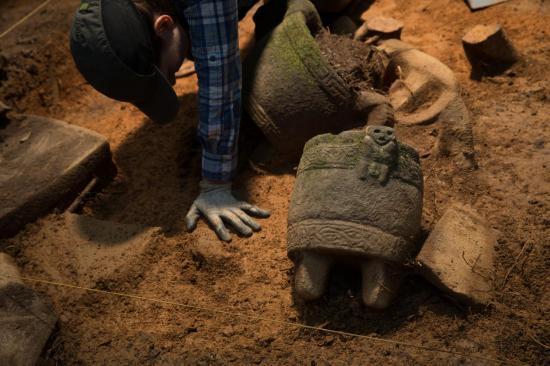More than 200 elaborate sculptures hint at the rituals and the tragic end of a “lost city" in Honduras.
Douglas Preston / Photos: Dave Yoder
Source - http://news.nationalgeographic.com/2016/02/160209-honduras-lost-city-archaeology-discovery-jaguar-sculptures-photos/
 Chris Fisher, the team’s chief archaeologist (center), Rodrigo Solinís-Casparius (left), Ranferi Juarez (background), and Anna Cohen (right) at the site of the cache in Honduras; several exposed “metates,” or seats of power, are in the foreground. PHOTOGRAPH BY DAVE YODER, NATIONAL GEOGRAPHIC
Chris Fisher, the team’s chief archaeologist (center), Rodrigo Solinís-Casparius (left), Ranferi Juarez (background), and Anna Cohen (right) at the site of the cache in Honduras; several exposed “metates,” or seats of power, are in the foreground. PHOTOGRAPH BY DAVE YODER, NATIONAL GEOGRAPHIC
Over the past month, the excavation of an ancient city in Honduras has yielded a trove of remarkable stone artifacts from a mysterious, unnamed Pre-Columbian civilization. A joint American-Honduran team of archaeologists uncovered and removed more than 200 sculptures from the base of a large earthen mound at the center of the site, which is being called the “City of the Jaguar.”
The artifacts, some whole and some broken, were flown by helicopter to a laboratory near the town of Catacamas that was recently built to study and house them .
“The cache is an ofrenda” or offering, said Chris Fisher, an archaeologist at Colorado State University in Fort Collins, who headed the team. “It’s like a shrine.” Caches of objects have been reported in other areas of eastern Honduras, but this is the first one ever to be professionally excavated.
Sculptures from the City of the Jaguar
 One of the more remarkable objects spied in the cache during the February 2015 expeditions was the head of a were-jaguar, just peeking out of the ground, almost completely obscured in vegetation. It was attached to this metate, or ceremonial seat. PHOTOGRAPH BY DAVE YODER, NATIONAL GEOGRAPHIC
One of the more remarkable objects spied in the cache during the February 2015 expeditions was the head of a were-jaguar, just peeking out of the ground, almost completely obscured in vegetation. It was attached to this metate, or ceremonial seat. PHOTOGRAPH BY DAVE YODER, NATIONAL GEOGRAPHIC
The excavation revealed that the objects had been carefully placed together, all at one time, on a prepared floor of red clay. They were arranged around a key object: an enigmatic sculpture of a vulture with partially spread wings. Ritual stone vessels surrounded it, their rims decorated with vultures and snakes. Some vessels had carvings depicting a strange humanoid figure with a triangular head, hollow eyes, and an open mouth on a withered-looking body. Fisher thinks these might depict a “death figure,” perhaps the bundled corpse of an ancestor prepared for burial.
Around the central cluster of artifacts, Fisher and his team exposed many stone “metates,” which look like curved tables with three legs used for grinding corn, but much larger and more ornate. They are believed to be seats of power, and many in the cache were carved with animal figures and geometric designs. This group included the “were-jaguar” head, which gave the city its name, thought to represent a shaman in a half-animal, half-human state. The artifacts probably date to the Mesoamerican Post-Classic phase, between AD 1000 and 1520.
The Pre-Columbian city was discovered in 2013 using an aerial survey method called lidar that uses pulses of laser light to map the ground. The city was hidden under triple-canopy jungle in an unexplored valley, ringed by mountains, in a remote region known as La Mosquitia. Archaeologists first entered the ruins in February, 2015 and happened upon the cache on the second day of exploration.
The excavated area encompasses less than 200 square feet of the enormous archaeological site, which includes at least 19 prehistoric settlements, probably part of a single chiefdom, spread along several miles of a river. One of the nearby sites has two parallel mounds that may be the remains of a Mesoamerican ballcourt similar to those left by the Maya civilization, indicating a link between this culture and its powerful neighbors to the west and north. The ballgame was a sacred ritual that re-enacted the struggle between the forces of good and evil, and might also have been a way for groups to avoid warfare by solving conflicts through a match instead. The ballgame was sometimes associated with human sacrifice, including the decapitation of the losing team or its captain.
While the City of the Jaguar is spectacularly isolated now, at its heyday it was probably a center of trade and commerce. “When you’re here today,” Fisher said, “you feel so disconnected. It’s a wilderness, and it’s hard to imagine you’re even in the 21st century. But in the past, it was in the midst of an intense network of human interaction. It wasn’t isolated at all.”
Some of the metate legs have puzzling markings on them. One set of cross-banded motifs, according to archaeologists who examined it, resemble a Maya “sky band,” similar to depictions of the night sky found under seated figures in sculptures at Chichen Itza in Mexico. Crossed-banded motifs are often associated with gods and objects of power in the Maya world. The metates also display many puzzling pseudo-glyphs on them that have yet to be studied and deciphered. (Pseudo-glyphs are designs with specific meanings that, unlike Maya glyphs, fall short of actual writing.)
Some archaeologists believe the metates may have been used not just as thrones, but also as seats for carrying the bundled and decorated bodies of the dead to their final resting place. Eventually, the jars and metate surfaces will undergo “residue analysis,” which could determine what offerings might have been inside them, or what substances (if any) were ground up on them.
 The archaeological team works on the cache site: Chris Fisher (foreground), Anna Cohen (right), Rodrigo Solinís-Casparius (left), Jason Bush (upper middle), and Iain Matheson (upper right). PHOTOGRAPH BY DAVE YODER, NATIONAL GEOGRAPHIC
The archaeological team works on the cache site: Chris Fisher (foreground), Anna Cohen (right), Rodrigo Solinís-Casparius (left), Jason Bush (upper middle), and Iain Matheson (upper right). PHOTOGRAPH BY DAVE YODER, NATIONAL GEOGRAPHIC
What was the meaning behind the cache? Why was it left there? One object in particular gives a vital clue. It is a stone “mano,” a heavy grinding roller carved out of basalt and finely polished. It is more than three feet long, an awkward size to have been actually used for grinding, indicating it was probably a ritual object. The archaeologists found it busted into six pieces, even though it is anything but fragile. This is evidence, Fisher believes, that it was “ritually broken,” which leads him to suspect that other fragmented sculptures found in the cache were also deliberately smashed. Ancient people throughout the Americas engaged in the purposeful breaking of objects and the “killing” of pots (by punching a hole in the bottom), before placing them in graves.
These clues, taken together, suggest the cache might have been created during a ritual closing of the city, at the time of its final abandonment. In this (admittedly speculative) scenario, the last inhabitants of the city gathered their most precious, sacred objects and left them as a final offering to the gods as they departed—breaking them perhaps as a way to release their spirits.
 Archaeologist Anna Cohen works in the central area of the cache, where ritual vessels were found arrayed around a stone vulture. PHOTOGRAPH BY DAVE YODER, NATIONAL GEOGRAPHIC
Archaeologist Anna Cohen works in the central area of the cache, where ritual vessels were found arrayed around a stone vulture. PHOTOGRAPH BY DAVE YODER, NATIONAL GEOGRAPHIC
Why was the city abandoned? While we have no proof, epidemics of European disease were the likely cause. At the time of European contact, Maya and Chibcha traders in giant dugout canoes engaged in far-flung commerce, exchanging goods between Honduras, Mexico, and the Caribbean islands. These same canoe merchants plied the great rivers flowing out of Mosquitia, paddling inland to acquire cacao, macaw feathers, and other valuable forest products. By the early 1500s, European diseases—smallpox, measles, and influenza—were raging across the islands of the Caribbean, killing up to 95 percent of indigenous inhabitants. Native traders very likely brought these diseases up the rivers into Mosquitia, where they escaped into the local populations and burned deep into the hinterlands, reaching areas far beyond the range of actual European contact. In this way, the City of the Jaguar may have been devastated by waves of epidemic diseases. The survivors, shattered and traumatized, eventually abandoned the city, leaving this cache behind, where it remained untouched for 500 years—a tragic memorial to a once great and now vanished culture.
PART.2